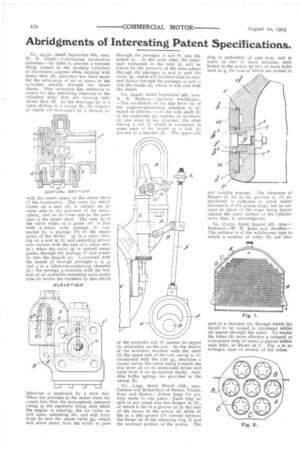Abridgments of Interesting Patent Specifications.
Page 20

If you've noticed an error in this article please click here to report it so we can fix it.
No. 19,35i, dated September 8th, 1904. W. M. Smith.—Lubricating locomotive cylinders.—In order to prevent a vacuum being lormed in the working cylinders of locomotive engines when running with steam •shut off, provision has been made for the admission of air or steam to the cylinders usually through the steam chests. This invention has reference to means for also admitting lubricant to the cylinders when they are running with steam shut off. In the drawings (a) is a valve sliding in a casing (b), the interior of which communicates by a branch (c) with the steam space of the steam chest of the locomotive. The valve (a), which closes on a seat (d), is subject on its outer side to the pressure of the atmosphere, and on its inner side to the pressure of the steam chest. The stem (el of the valve slides in a guide (el) in line with a steam inlet passage (f I connected by a passage (fl) to the steam space of the boiler. (g) is a valve closing on a seat at (h) and extending almost into contact with the end of a valve stem (e); when the valve (g) is opened steam passes through the passage If) and nozzle (i) into the branch (Cl. Connected with the nozzle (0 through passages t, 2, 3, and 4 is a lubricant-containing chamber (5); the passaga 4 connects with the bottom of an upwardly extending open-ended tube (6) within the chamber (5) into which
lubricant is syphoned by a wick (6a). When the pressure ii the steam chest becomes less than the atmospheric pressure owing tc.) the regulator being shut while the engine is running, the air valve (a) will open, admitting air, and will force from its seat the steam valve (g), which will allow steam from the boiler to pass
through the passages (1 and fl) into the nozzle (i). At the same time, the lubricant contained in the tube (6) will be forced by the pressure of the atmosphere through the passages (4 and 3) past the valve (9), which will be lifted from its seat, and thence through the passages (2 and 1) into the nozzle (i), where it will mix with the steam.
No. 19,428, dated September 9th, 1904A. R. Bellamy.—Ignition mechanism. —The oscillation of the trip lever (a) of the magneto-generating machine is effected as fellows :—On the side shaft (b) of the stationary gas engine, an eccentric (d) arid strap (e) are mounted, the strap having a rod (f) which is connected at some part of its length to a link (g) pivoted to a bracket (Ili. The upper end
of the eccentric rod (f) carries its tappet (h) adjustable on the rod. As the sheave of the eccentric revolves with the shaft (d) the upper end of the rod, owing to its connection with the link (g), describes a closed curve, the curve being towards the trip lever (a) on its downward stroke and away from it on its upward stroke. Suitable buffer springs are provided in the casing (lc).
No. 5,549, dated March i6th, 1905. Gordon and McKechnie of Messrs. Vicars, Sons and Maxim.—Piston rings for pistons made in one piece.—Each ring (a) split in any usual way has flanges (b,
of which h fits in a groove (c) in the side of the recess in the piston (d) while bl fits in a like groove (cl) formed between the flange (e) of the retaining ring (f) and the recessed portion of the piston. The ring is preferably of cast iron, and is made in two or more sections, each bolted to the piston by two or more bolts such as g, the nuts of which are locked in any suitable manner. The clearance of flanges (b, bl) in the grooves (c, cl) respectively is sufficient to allow radial movement of the piston rings, but in sufcient to allow of the rings being forced against the inner surface of the cylinder more than is advantageous.
No. 17,172, dated August 5th, 1904.Radiator—W. H. Kitt° and Another.— The radiator is of the well-known type in which a number of tubes (B) are situ ated in a chamber (A), through which the liquid to be cooled is circulated whilst air passes through the tubes. To render the tubes (B) more effective a crimped or corrugated strip of metal is placed within each tube, as shown at C. Fig. 2 is an enlarged view of several of the tubes.




















